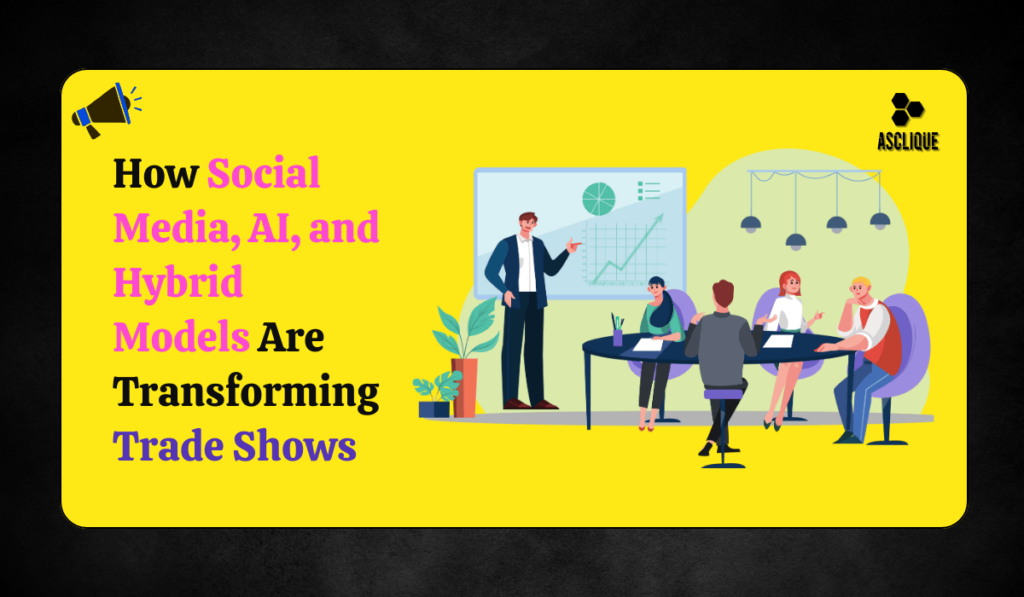Traditionally, trade shows have been an important platform for businesses to expose their products, network, and generate leads since times immemorial. The rapid shift of trade shows is being influenced by the advancement of digital marketing, especially social media. The future social media landscape is creating a new way of connecting exhibitors and attendees and offering real-time engagement and extended reach beyond physical events.
The paper is going to describe how social media is revolutionizing trade shows, what trends in the near future will give these events their shapes, and what companies should use this information for better organization.
The Future of Trade Shows: The Role of Social Media
Social media is changing the face of trade shows, and businesses are finding new ways to embrace their audiences, expand their reach, and create experiences that are extremely participatory. The future of social media for trade shows will be shaped by the following three effective strategies:
Real-time engagement and live streaming
Social media enables real-time activity, thus meaning that audiences experience exhibitions beyond a venue. These are Instagram Live, Facebook Live, LinkedIn Live, and Twitter Spaces, through which businesses can cast their product launches, keynote speeches, and all those behind-the-scenes moments.
How businesses can improve engagement at trade shows:
- Cast keynotes and product demos live.
- Conduct live Q&A sessions for higher interaction.
- Invite attendees to share experiences on branded hashtags.
- Cooperate with influencers for easier access to greater audiences.
Stronger Networking Platform
Trade fairs are strictly about connections; social media intensifies networking channels. With services like LinkedIn and X, or formerly known as Twitter, an individual can contact other professionals operating in the given industry, event-specific groups both on Facebook and LinkedIn bring on a feeling of community.
Effective networking via social media:
- Start and participate within event-based groups.
- Arrange meetups with leads on LinkedIn.
- Comment on all event-related activities to be recognized.
- Pre-event interactions and follow-ups: Social media calendar.
Influencer Marketing and Brand Ambassadors
Influencer marketing is one of the major strategies that are used in trade shows. Industry influencers and brand ambassadors can create buzz and attract attendees by sharing content and tagging exhibitors.
Successful influencer marketing tactics:
- Partner with influencers to promote your booth.
- Offer exclusive deals or content for attendees engaging with influencers.
- Host influencer-led discussions and product demos.
- Use micro-influencers to better target niche audiences.
Using such strategies, a business will make the most out of a trade show, improve engagement, and expand the effects beyond the actual event.
Emerging Trends in Trade Show Social Media Strategies
Trade show future social media strategies are evolving in tandem with advancements in technology that help increase engagement and reach. Three emerging trends in the industry include:
Augmented Reality (AR) and Virtual Trade Shows
Social media is revolutionizing the way trade shows take place with the use of AR and VR. Events can be more interactive and accessible through such media. Companies are using AR filters, 3D product showcases, and virtual walkthroughs to engage both in-person and remote attendees.
Key advantages of AR/VR in trade shows:
- Creates immersive product experiences.
- Fills the gap for remote participants.
- Promotes social sharing of interactive content.
- Helps exhibitors create virtual booths that can be accessed from anywhere.
User-Generated Content and Hashtag Campaigns
Amplifying the brand visibility of attendees who create and share content is done. Branded hashtags, interactive photo booths, and social media challenges make trade shows engaging and help extend the reach of the brand.
Best practices for user-generated campaigns:
- Create an official event hashtag through which easy content tracking may be done.
- Provide incentives to generate high-quality content among the attendees.
- Share user-generated posts on the official company social media pages.
- Create a post-event gallery showing the best photographs and videos.
AI-Powered Chatbots and Personalized Interactions
AI-driven chatbots on social media platforms enhance trade show engagement through instant support, personalized recommendations, and real-time event updates.
How AI enhances trade show interaction:
- It offers instant responses to attendee queries.
- It suggests the relevant booths and sessions.
- Collects data for post-event analysis.
- Helps exhibitors analyze visitor behavior and optimize engagement strategies.
By using AR, AI, and user-generated content, businesses can redefine their trade show experience and create lasting connections with their audience.
Leverage Social Media for Best Trade Show ROI
Businesses should prepare before, during, and after the event to maximize the potential of the trade show future social media strategies. Here’s how:
Pre-Event Promotion Strategies
Pre-event hype is essential to get people to attend the trade show. A well-thought-out pre-event social media campaign can create excitement and engagement.
Pre-event social media checklist:
- Announce participation with attention-grabbing graphics and videos.
- Host countdown posts before the event.
- Offer incentives or special deals for early registration.
- Launch teaser campaigns with special guests, product launches, or even giveaways.
Event: Engagement Amplification
Live engagement keeps attendees engaged and motivates further sharing. Social media allows for live interaction to enhance visibility and attract more visitors to the booth.
Top engagement tactics:
- Promote live tweeting and social media discussions.
- Use interactive polls, Q&A sessions, and giveaways.
- Share real-time event highlights, testimonials, and behind-the-scenes content.
- Run targeted ads on social media to drive in foot traffic.
Following the Event/Retargeting
The actual success of this trade show starts after the trade show. Businesses must continue engaging with attendees through social media follow-ups and retargeting ads.
Effective post-event strategies:
- Recap videos, blog posts, and key takeaways.
- Follow up on new connections via LinkedIn and email marketing.
- Run retargeting ads to re-engage users who interacted with your content.
- Conduct a post-event survey to gain insights and improve future strategies.
By leveraging social media at every stage, businesses can maximize trade show impact, strengthen relationships, and boost long-term brand engagement.
The Future of Trade Shows: A Hybrid Model
As future trade show social media strategies advance, hybrid trade shows—integrating the physical with digital experience—will define the future. This requires that business incorporate both online and offline interaction for full engagement reach and return on investment.
Important learnings for future trade show strategy:
- Virtual experiences to supplement booths are needed for reach remote audiences
- Use AI to enhance personalization for a user
- Use content marketing for the purpose of amplifying event promotion.
- Implement data-driven strategies to track performance and optimize future participation.
The Role of Data Analytics in Trade
Data analytics is quickly emerging as a game-changer for trade show future social media campaigns. Businesses need to track KPIs measuring engagement and effectiveness.
KPIs to Track
- Social media impressions and reach to measure brand exposure.
- Engagement rates by likes, shares, comments, and mentions to measure audience interaction.
- Hashtag performance to measure the success of a campaign.
- Booth foot traffic produced by the social media campaigns.
- Lead generation and conversion rates for ROI determination
Hybrid trade shows and data analytics are the tools that help businesses stay at the industry forefront, enhance audience engagement, and achieve future success.
Conclusion
The future social media evolution for trade shows creates opportunities for businesses that have never existed before: the opportunity to connect, engage, and convert prospects. New technologies, influencer partnerships, and data-driven social media strategies now enable businesses to maximize their success potential in this digital age.
Companies need to embed social media into every stage of trade show planning; it should not just reflect but also extend beyond the confines of the event floor. The future of trade shows lies not only in being in-person but is a digital-first, interactive, and socially powered experience.
FAQs
How is social media changing trade shows?
Through real-time engagement, broader audience reach, and live interactive experiences by allowing the streaming and influencer approaches and using hashtags.
What are the benefits of AI chatbots in a trade show?
AI chatbots provide instant answers, personalized suggestions, and direct attendees through the event for a better overall engagement and efficiency.
How do companies use influencer marketing in trade shows?
The company will use influencers to endorse booths, carry out live demonstrations of the products, and have content that engages more people in the booths.
What is the future of the trade show and augmented reality (AR)?
AR will change how trade shows operate. AR can enhance trade show experiences through virtual product demos, interactive filters, or digital walkthroughs that remote attendees can use.
How do companies measure trade show social media success?
Key metrics include social media impressions, engagement rates, hashtag performance, lead generation, and booth foot traffic driven by digital campaigns.

